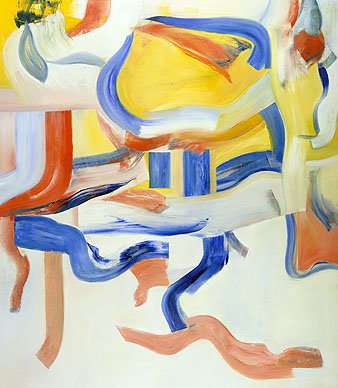Willem de Kooning
dal 5/7/2006 al 23/9/2006
Segnalato da
5/7/2006
Willem de Kooning
State Hermitage Museum, St. Petersburg
The exhibition features more than 20 works dating from the period 1981-1988, including a triptych from 1985 which de Kooning painted for St Peter's Church in New York. These late canvases by the celebrated American artist were done in his studio on Long Island and many are presently held in private collections in Switzerland and in the USA.

20 works dating from the period 1981-1988
The exhibition in the Nicholas Hall presents paintings by a classic name in American abstract expressionism, Dutch-born Willem de Kooning (1904-1997). The exhibition coincides with this year's homage to Rembrandt on the 400th anniversary of his birth.
The exhibition has been organized by the State Hermitage together with the Willem de Kooning Foundation, New York, with support from Access Industries, the ACE Group of Companies, the Lerman Institute and the American Club of Friends of the Hermitage.
The exhibition features more than 20 works dating from the period 1981-1988, including a triptych from 1985 which de Kooning painted for St Peter's Church in New York. These late canvases by the celebrated American artist were done in his studio on Long Island, USA and many are presently held in private collections in Switzerland and in the USA.
Willem de Kooning was born in Rotterdam, the Netherlands. Up to 1924 he studied in the local Academy of Fine Arts. In 1926 he emigrated illegally to the USA and worked as a house painter in Hoboken, New Jersey. In 1927, de Kooning moved to New York, where he became acquainted with the artists John Graham, Stewart Davis, David Smith and Arshile Gorky. A large part of his art work is connected with New York, where he became a celebrity in the 1950s. De Kooning's first one-man show took place in New York in 1948. In that year the Museum of Modern Art, New York, purchased its first work by him. In 1964 U.S. President Lyndon Johnson awarded de Kooning the Presidential Medal of Freedom, which is America's highest civilian award, and in 1979 de Kooning became a knight of the Dutch Order of Orange-Nassau. The artist became a U.S. citizen in 1962. In 1963 he moved to Springs on Long Island, New York.
Willem de Kooning's style developed in the context of American art of the mid-20th century, though the maitre never lost his original ties to European art. An inner dialogue with Henri Matisse, Pablo Picasso and Vasily Kandinsky can clearly be felt in his art over the course of many years.
Among American abstractionists of the mid-20th century, Willem de Kooning was noted for his conservatism. His paintings invariably have a strict tectonic structure to the composition, while the colors on the canvas are devoid of dissonance. He stayed true to traditional materials and painterly techniques. The maitre's paintings are complex and executed in a virtuoso manner.
De Kooning's later years, when he was more than 70, were perhaps the most interesting and fruitful time of his life. His canvases from this period acquired total freedom of color, line and shape. Precisely the late works by Willem de Kooning, made in the 1980s, were destined to become the most light and life-affirming works, the great artist's unique spiritual testament.
The exhibition is a continuation of the series of exhibitions intended to familiarize Hermitage visitors with the major masters of modern art.
The curator of the exhibition Willem de Kooning. Late Paintings is Julia Sylvester, Guest Curator of Modern Art of the State Hermitage. This is her third project as curator in the museum. Her previous Hermitage exhibitions Louise Bourgeois (2001) and Cy Tombley (2003) were very successful.
A scholarly illustrated catalogue to the exhibition has been published by Schirmer/Mosel, Munich with support from the Gagosian Gallery, New York. The catalogue has an introductory article by Mikhail Piotrovsky, Director of the State Hermitage, and an article by Julia Sylvester. The text of the catalogue was written by the English art critic David Sylvester.
When the exhibition closes in the State Hermitage, it will move to the Carlo Bilotti Museum in Rome.
State Hermitage Museum
2, Dvortsovaya Ploshchad - St. Petersburg
Opening hours: daily, except Mondays, from 10:30 a.m. to 6 p.m.
Admission: 350 rubles



